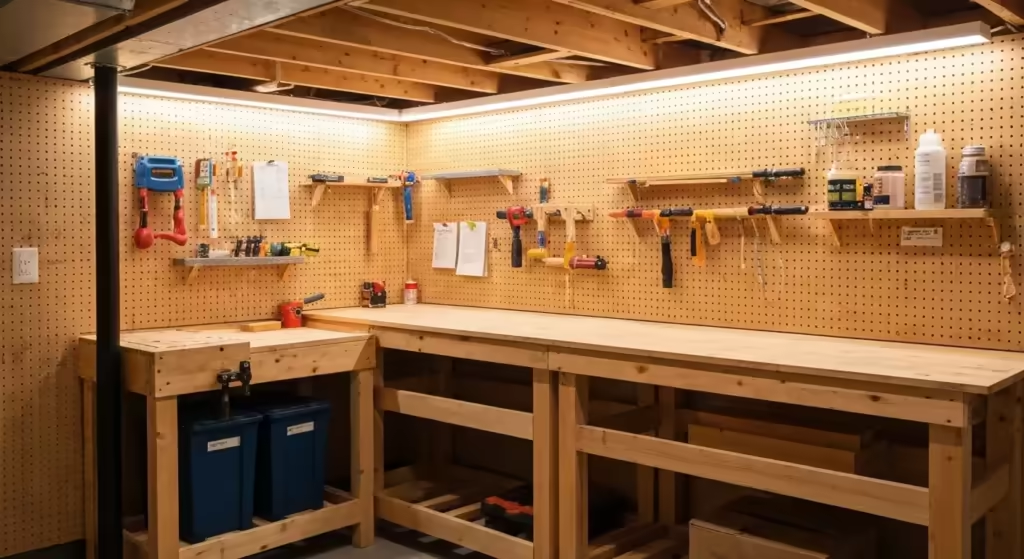The first time I walked into Home Depot as a newly retired man, I felt a surge of pure, unadulterated excitement. My wife, Sarah, and I had just closed on our “forever home,” a lovely little ranch-style house that needed more than a little TLC. After forty years as an accountant, tethered to a desk and spreadsheets, the idea of working with my hands, of building and fixing and creating tangible things, was intoxicating. The vast warehouse, with its towering orange shelves and the smell of cut lumber, felt like a cathedral of possibility.
That feeling lasted for about fifteen minutes.
Our first project was supposed to be simple: update the tiny guest bathroom. New toilet, new vanity, new floor, a fresh coat of paint. How hard could that be? I grabbed a cart and started down the aisles, brimming with confidence. I picked out a nice, standard toilet. Cha-ching. A handsome little vanity with a cultured marble top. Cha-ching. Some modern-looking vinyl plank flooring. Cha-ching. By the time I got to the paint counter and added a gallon of primer, a gallon of a nice calming blue, rollers, trays, and tape, my mental calculator was screaming.
I remember standing there, under the harsh fluorescent lights, looking at my cart. It wasn’t filled with luxuries. It was the basic anatomy of a small bathroom renovation. I did a quick, rough tally in my head and my heart sank. This “simple” project was already cresting a thousand dollars, and I hadn’t even bought the new light fixture, mirror, or towel racks yet.
The excitement drained out of me, replaced by a cold knot of anxiety in my stomach. This was our retirement. Our income was fixed. We had a budget, a carefully planned document I had created myself, but the reality of project costs was a sledgehammer to its delicate structure. I felt a wave of naivete wash over me. I had planned for our groceries, our utilities, our travel, but I hadn’t truly grasped the cost of turning this house into our home. I ended up putting half the items back on the shelves that day, telling the cashier I’d “be back later.” I walked out to the parking lot feeling defeated, the scent of sawdust now smelling like money I didn’t have. That was the moment I knew my old approach—just buying what I needed when I needed it—was a luxury I could no longer afford. I had to get smart. I had to learn the system. My new part-time job wasn’t going to be woodworking or gardening; it was going to be mastering the art of the Home Depot deal.
My Clumsy Beginnings: Learning the Hard Way
My first attempts at saving money were, to put it mildly, pathetic. I felt like a freshman on the first day of school, trying to look like I knew where I was going but fooling no one. My strategy, if you could call it that, was to wander the aisles looking for those bright yellow and red clearance tags. I figured, “Clearance means cheap, right?”
I remember one of my early “victories.” I found a box of ceramic tiles on a clearance endcap for 70% off. They were a bit of an odd, mustardy color, but the price was incredible. I bought every box they had, convinced I’d use them for that guest bathroom floor. I proudly showed Sarah, boasting about my incredible find. She gave me that look—the one that’s both loving and deeply skeptical.
A week later, when I actually started prepping the bathroom, I realized my mistake. The tiles were an odd size, which meant a lot more cutting. Worse, after laying out half the floor, I discovered I was about ten square feet short. When I went back to Home Depot, of course, they were long gone. There was nothing similar in that color or size. I had two choices: rip out all my work or create a bizarre, mustard-yellow-and-something-else floor. The “deal” ended up costing me time, frustration, and the price of a whole new floor, because I ended up ripping it all out. The mustard tiles of shame sat in my garage for a year before I gave them away.
Another time, I bought a power drill on sale. It was a brand I’d never heard of, but the box boasted all sorts of features and the price was a good forty dollars less than the Ryobi I’d been eyeing. It worked fine for a few small jobs, but the first time I tried to drill through a pressure-treated 4×4 for a garden fence, the motor let out a pathetic whine and a wisp of smoke. The battery life was abysmal. I had saved forty dollars upfront only to buy the Ryobi drill a month later anyway. The cheap drill became a monument to my “penny wise, pound foolish” phase.
These weren’t just financial mistakes; they were blows to my ego. I was supposed to be the smart, careful accountant. Instead, I felt like a sucker, falling for the most obvious traps. I was letting the store dictate my projects based on random deals rather than letting my projects dictate my deal hunting. The frustration was immense. I knew there were people who did this well, who built beautiful things on a budget. I just wasn’t one of them. Not yet.
The Big “Aha!” Moment: From Impulse Buyer to Master Planner
The turning point came not in an aisle at Home Depot, but at my own kitchen table, surrounded by receipts, half-baked project notes, and a growing sense of despair. Sarah sat down across from me, slid me a cup of coffee, and said, “You’re an accountant, John. You plan for multi-million dollar corporations. Why don’t you plan for our own deck?”
It was so obvious it hurt. I was treating my home projects like a weekend hobby when I should have been treating them like a professional job. My entire career was built on meticulous planning, foresight, and tracking every single line item. It was time to bring my professional skills home.
That afternoon, I bought a simple three-ring binder. This became my “Project Bible.” I created a section for every major project we dreamed of: the Deck, the Kitchen Refresh, the Garden Beds, the Basement Workshop. The very act of writing them down made them feel more manageable, less like a tidal wave of expenses.
For our next big project—a small ground-level deck off the back patio—I went all in. I didn’t just write “deck.” I sat down for hours, sketching the design and breaking it down into an exhaustive list.
- Foundation: 12 concrete deck blocks.
- Frame: 20 pressure-treated 2x6x8 boards.
- Decking: 30 cedar 5/4x6x12 boards.
- Hardware: 5 lbs of 3-inch deck screws, 2 lbs of 1 5/8-inch screws, 20 joist hangers.
- Finishing: 2 gallons of waterproof sealant, 2 paint brushes.
I researched everything. I calculated the exact number of boards I’d need, adding a small percentage for waste. I specified the type and size of every single screw. The list was pages long. It felt like overkill at first, but then something magical happened. My anxiety started to fade, replaced by a sense of control. This list wasn’t just a shopping list; it was a roadmap. It was my defense against impulse buys and my shield against the store’s seductive marketing.
With this binder in hand, my trips to Home Depot changed completely. I no longer wandered aimlessly. I went in with a surgical purpose. I wasn’t there to browse; I was there to execute a mission. I knew exactly what I needed, which meant I could focus all my energy on finding the best price for those specific items. This shift in mindset was everything. It was the moment I stopped being a consumer and started being a project manager. The binder was my secret weapon, and it was about to help me unlock a whole new level of savings.
Cracking the Code: My Personal Home Depot Deal-Hunting System
Armed with my Project Bible, I felt like a detective on a case. The mystery: where were the real deals hiding? I started to observe, to listen, and to connect the dots. Over the next year, I developed a multi-pronged strategy that transformed my budget and my confidence. These weren’t tricks I read in an article; they were lessons learned on the ground, through trial, error, and a little bit of luck.
1. The Archeology of the Clearance Aisle
My first breakthrough was realizing that not all clearance is created equal. The mustard tiles taught me that a cheap price on the wrong item is no deal at all. But a cheap price on something from my Project Bible? That’s gold.
I also learned to read the secret language of the yellow price tags. I started noticing a pattern. Prices ending in “.06” were on their first markdown. They were okay deals. But the real treasure was the price ending in “.03.” I learned from a friendly cashier that this was the final markdown. The store wanted it gone, yesterday. If you see a “.03” on an item you actually need, you don’t walk, you run to the checkout.
My greatest “.03” find was for our kitchen refresh. Sarah wanted an elegant, high-arc faucet, the kind that costs a small fortune. I had a specific Moen model in my binder, priced at $229. For months, I watched it. Then one day, I was doing my weekly “reconnaissance walk” through the store and I saw it. A single, solitary box on a clearance shelf, looking a little beat up. The tag was yellow. The price was $57.03. My heart did a little flutter. It was an open-box return, but all the parts were there (I checked right in the aisle). We’ve had that faucet for three years now, and every time I use it, I feel a ridiculous amount of pride. That single find paid for my entire education in clearance hunting.
2. The Beauty of “Ugly” Wood: My Love Affair with Cull Lumber
Every Home Depot has a place for “cull lumber.” It’s usually a big, messy-looking cart tucked away in the back of the lumber section. This is wood that’s been warped, twisted, cracked, or discolored. Most people walk right past it. For a long time, I did too. It looked like junk.
But my Project Bible taught me that not all projects require pristine, perfect lumber. For the raised garden beds I wanted to build, the wood just needed to be structurally sound. One afternoon, I decided to brave the cull cart. I spent thirty minutes sorting through the pile, getting my hands dirty. And what I found was amazing. There were plenty of boards with a slight twist that could easily be straightened when screwed into a frame. There were boards with ugly discoloration on one side that would be facing the dirt anyway. There were 12-foot boards with a cracked end, but I only needed 8-foot sections.
The store stamps this wood with a purple mark and sells it for a flat, deeply discounted rate—often 70% off or more. That day, I bought all the wood I needed for four massive raised garden beds for about $40. If I had bought new, perfect lumber, it would have cost me closer to $200. It took a little extra effort to sort through the pile, but the savings were astronomical. Now, the cull lumber cart is my first stop on any project that doesn’t require cosmetically perfect wood, like garage shelving or workbench frames.
3. Embracing the Digital Age: The App and the Email List
Like many people my age, I was initially resistant to getting another app on my phone or signing up for another email list. I didn’t want the spam. But I swallowed my pride when I saw a sign offering a $5 coupon just for signing up for their email newsletter. Five bucks is five bucks.
It turned out to be one of the smartest things I did. The Home Depot app is surprisingly useful. I can check the inventory and aisle location of an item before I even leave the house. No more wandering around searching for some obscure plumbing fitting. But the real power is in the “Special Buy of the Day.” Every day, they feature a handful of items at a massive discount, online only.
Because I had my Project Bible, I knew what I would need months in advance. I made a habit of checking the Special Buy every morning with my coffee. Most days, it was nothing I needed. But then, one Tuesday, I hit the jackpot. They had a 24-pack of the exact concrete deck blocks I needed for our deck project for 40% off. I bought them online, selected “in-store pickup,” and they were waiting for me an hour later. That one click saved me over $50 and a lot of heavy lifting.
4. Building Alliances: The Power of a Friendly Face
This might be the most important lesson I learned. Technology and planning are great, but nothing replaces human connection. I used to be intimidated by the store associates in their orange aprons, afraid of asking a “stupid” question.
I decided to change that. I started making a point to be friendly, to ask for names, and to seek out the same people. My greatest ally became a man named George in the plumbing department. George was a retired plumber who worked at Home Depot part-time to stay busy. He had forgotten more about plumbing than I would ever know. When I was tackling the guest bathroom, I showed him my plans. He didn’t just point me to the right parts; he told me which ones were easier to install for a DIY-er. He explained why a certain brand of wax ring was better than another. He gave me tips that saved me hours of frustration.
One day, while chatting with him, I mentioned I was keeping an eye out for a deal on a specific wet-tile saw for the kitchen backsplash I was planning. He nodded and said, “You know, we have our big tool rental event coming up in a few weeks. They usually sell off some of the older rental models for cheap. They’re well-maintained. Come see me around then.” Sure enough, three weeks later, I walked out with a professional-grade tile saw for less than the price of a new consumer model. No app or website would have ever told me that. That was pure, old-fashioned, human-to-human advice. I now have “allies” like George in electrical, lumber, and the garden center. They are an invaluable resource.
5. Playing the Long Game: Timing, Rebates, and Big Purchases
My final piece of the puzzle was learning patience and timing. I learned that home improvement has seasons, just like gardening. You don’t buy a grill in May; you buy it in September when they’re clearing them out. You buy snow blowers in April. You buy paint during holiday weekends when they almost always have a rebate or sale. My Project Bible allowed me to anticipate these cycles. I would plan to build the deck in late spring, but I’d start buying the materials in the fall and winter, picking up deals as they appeared.
I also learned to play the rebate game. Home Depot occasionally runs an 11% rebate promotion to match a similar deal from their competitor, Menards. It requires a bit of paperwork—you have to mail in your receipts—but for a big project, it’s absolutely worth it. When we did our deck, I timed the bulk of my lumber purchase to coincide with one of these rebates. A few months later, I got a store credit gift card in the mail for over $150. That gift card paid for all the sealant and the new light fixture for the back porch.
This strategy also applies to their credit card. I’m not a fan of opening store cards, but when our 20-year-old refrigerator finally died, the choice was clear. By opening a Home Depot card for that one large purchase, we got a significant discount off the top—I think it was $100 off—and we were able to take advantage of 24 months of interest-free financing. It made a huge, unexpected expense manageable. We paid it off systematically, long before the interest kicked in, and the initial discount alone made it worthwhile.
The Fruits of My Labor: More Than Just Savings
Just last fall, I put the finishing touches on my basement workshop—the project I’ve dreamed about for decades. It has a long, sturdy workbench, pegboard walls for all my tools, and bright, clean lighting. As I stood there, looking at this space that I had built with my own two hands, I did a little calculation.
The workbench was built almost entirely from cull lumber. The pegboard was a “Special Buy of the Day.” The expensive LED shop lights were a final clearance “.03” item I’d found months earlier and stored away. The heavy-duty vise on the bench was an open-box return. By applying every lesson I had learned, I estimate I built out the entire workshop for about $400. A quick search online for pre-made workshop systems of similar quality showed prices starting at $1,500. I had saved over a thousand dollars on this one project alone.
But standing there in my new workshop, the feeling wasn’t just about the money. The thousand dollars was great, don’t get me wrong. It meant we could take that extra trip to see our grandkids this year without guilt. But the real payoff was a deep, quiet sense of pride and empowerment.
I looked back at the man who walked out of Home Depot that first day, feeling defeated and anxious about his finances. He was gone. In his place was someone who felt capable, resourceful, and in control of his own life. Learning to find these Home Depot deals wasn’t just a financial strategy; it was a way of reclaiming agency in a chapter of life where your income is no longer growing. It proved to me that I could still learn new tricks, solve complex problems, and provide for my family in a meaningful way.
This journey has made our home projects a source of connection for me and Sarah, not a source of stress. We plan them together, we hunt for the deals together, and we celebrate the victories together. Our home isn’t just being built with lumber and screws; it’s being built with patience, ingenuity, and the satisfaction of a job well done and a dollar well saved. And to me, that’s the best deal of all.














